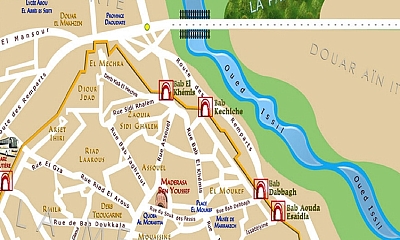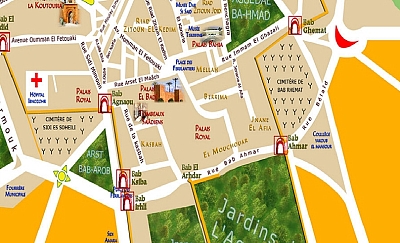Social Tours
and Sightseeing
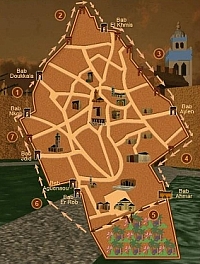 |
We offer you attractive tourist visits inside
Marrakech. We invite you to take part in several tours. On the
first tour you will discover the majestic ramparts, symbol of
the power. This rampart is 19 km long and has 19 gates and is a
true masterpiece of the medieval architecture. The 2nd tour
brings you to the famous Jamaa ElFna and to the souks of the
city, the world heritage of humanity. The 3rd tour, brings you
back to the northern part of the Medina where the museums of
Marrakech and the Medersa Ben Youssef are located and to see
neighborhoods housing the famous mausoleums. In the 4th tour,
the city offers you a visit to its southern area, far away from
the daily hustle and bustle. It will be a tour to the ancient
and sumptuous quarters of Marrakech. Nobody can omit the visit
of the Marrakech's fabulous gardens, showing the Arabic loyal
tradition. We suggest you do not miss the 5th tour to feel all
the beauty with a slow pace on an attractive horse and carriage. |
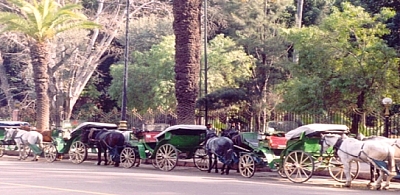 |
Further details will be made available on this web page. For each tour a minimum of participants is required. Some highlights
are listed here:
ST 1 - The Majestic Ramparts
Time: Wednesday 18 May and Friday 20 May, 14:00-17:00
Price:
40 EUR
Price includes bus and tourist guide.
Group: 30 persons
Language: English and French
More information:
The ramparts of Marrakech, were built in the early twelfth century by
the Almoravids.
10 meters high, about 19 km long, and flanked by 202 towers, they frame
the Medina, and give an idea of the historical importance of the city.
These walls built of adobe, present, depending on lighting, wonderful
reflections glowing.
Nine majestic doors of Moorish allow access to the medina. Some of them
have retained their original architecture and worth a visit.
ST 2 - Square Jamaa El Fna and Souks
Time: Thursday 19 May and Saturday 21 May, 14:00-17:00
Price includes bus
and tourist guide.
Group: 30 persons
Language: English and French
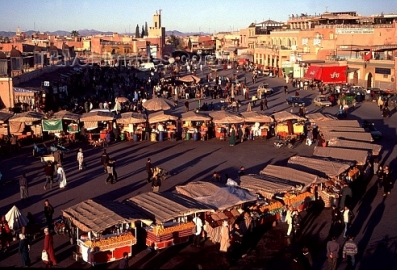 |
More information:
The place remains the main square of Marrakesh, used equally by
locals and tourists. During the day it is predominantly occupied by
orange juice stalls, youths with chained Barbary apes, water sellers in
colourful costumes with traditional leather water-bags and brass cups,
and snake charmers who will pose for photographs for tourists. As the
day progresses the entertainments on offer change: the snake charmers
depart, and in the afternoon and evening the square becomes more crowded,
with dancing, story-tellers, magicians, and peddlers of traditional
medicines.
Steam rises from food stallsThe square is edged along one side by the
Marrakesh souk, the traditional North African markets which service both
the common daily needs of the people of the city, and the tourist trade.
On other sides are cafe terraces to escape from the noise and confusion
down in the square, and on yet other sides are hotels and gardens.
Narrow streets lead into the alleys of the medina quarter, the old city.
The photograph illustrating this article shows the entrance to the souk
at the left, cafes in the centre, and the entrance to the medina via the
Street of the Olive on the right.
The UNESCO classifies the square as the Oral and Intangible Heritage of
Humanity with the aim to raise awareness about the importance of oral
and intangible heritage as an essential component of cultural diversity.
ST 3 - Marrakech Museums
Time: Friday 20 May, 14:00-17:00
Price: 40 EUR
Price includes bus,
entrance fees and tourist guide.
Group: 30 persons
Language: English and French
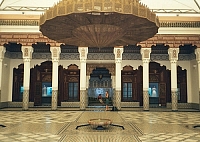 |
More information:
Marrakech has a fair collection of
museums which display artefacts relating to the city's rich
Moroccan past. Just about every museum within Marrakech is
housed in an impressive building of some sort, either
originating as a palace or a mansion that displays fine forms in
their own right.The Dar si Said Museum is a particular
must-see that does rather stand out. Do pay a visit to the
Marrakech Museum, which is actually housed in the traditional
stone-built Dar M'Nebhi Palace.
Situated in the stunning 19th century Dar M'Nebhi Palace,
next to the Medersa Ben Youssef, the Museum of Marrakech is
visited as much for its architecture as it is for its contents.
The central atrium is massive and covered by a domed tent
supported by pillars, and there are many exhibitions inside
showing off paintings, ceramics, and photography. A bookstore is
also onsite. |
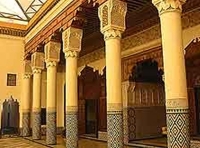 |
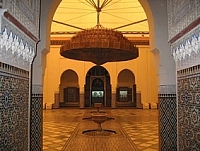 |
ST 4 - Sumptous and Ancient Palaces of Marrakech
Time: Sunday 22 May, 9:00-12:00
Price: 40 EUR
Price includes bus and
tourist guide.
Group: 30 persons
Language: English and French
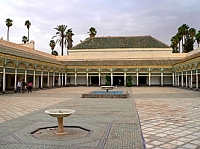 |
More information:
The El Bahia Palace and gardens were
built in the late 19th century, intended to be the greatest
palace of its time. The palace as in other buildings of the
period in other countries, it was intended to capture the
essence of the nations style.
This beautiful building is an excellent example of Eastern
Architecture from the 19th century that represents trends and
standards of the wealthy who lived at that time. There are 160
different rooms in the palace which are sprawled out in an open,
rambling fashion. The palace is surrounded by an eight-hectare
garden where visitors can literally lose themselves in the
beauty of the place.
The Saadian Tombs were built in the time of Sultan
Ahmad al-Mansur (1578-1603), of the Saadi dynasty. The tombs are
sumptuous and wonderful with the cemetery garden alive with rich
fragrances of rosemary and roses, with large palm trees
providing shade. Inside the mausoleums the beauty continues and
visitors will be surprised by the stunning domed ceilings,
detailed wood and marble carvings, mosaics and complicated
plasterwork.
The Badi' Palace was built in the Qasba during the
reign of Muhammad al-Shaykh al-Mansur (1578-1603). It has a
symmetrical plan with chambers and pavilions round a central
courtyard with water and planting. Four gardens open off the
courtyard. It is a luxurious palace, which was meant to be used
mostly for receptions. It was one of the most beautiful
buildings in the Muslim world and impressive for its size; just
the inner court is 135 by 110 metres and had 360 rooms. El-Badia
Palace is hidden behind its red coloured walls. |
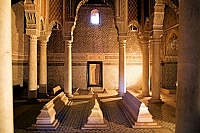 |
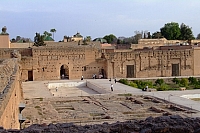 |
ST 5 - Fabulous Gardens by Attractive Horse and Carriage
Time: Saturday 21 May, 14:00-17:00
Price: 45 EUR
Price includes horse
carriages and tourist guide (4 persons per horse carriage)
Group: 40 persons
Language: English and French
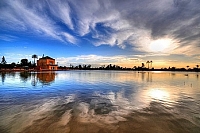 |
More information:
The Menara Gardens are located to the
west of Marrakech, at the gates of the Atlas mountains. They
were built in the 12th century (c. 1130) by the Almohad ruler
Abd al-Mu'min. The name menara derives from the pavillon with
its small green pyramid roof (menzeh). The pavilion was built
during the 16th century Saadi dynasty and renovated in 1869.
The Gardens of Agdal are located south of the Royal
Palace in the Kasbah area, the Agdal Gardens are divided by a
central alley, stretch out hundreds of hectares of splendid
12th-century orchards and olive groves.
The gardens are irrigated using a number of pools and ditches. A
network of underground channels and ditches, known as khettera,
bring water down from the High Atlas mountains many kilometres
away, via Aghmat in the Ourika Valley to the south.
The Dar El Hana, a small pavilion or minzah, stands beside the
largest pool, the Sahraj el-Hana (Tank of Health), which was
used to train troops to swim.
The Majorelle Gardens are nice and peaceful. This
beautifully laid out garden was created by French artist Jacque
Majorelle in the 1920s. They are built around his studio which
now houses a museum. They are in the middle of the city but once
you get inside the doors of the gardens it feels like you are a
million miles away. You cannot hear any of the traffic noise and
it is very peaceful. The gardens are a mix of exotic plants and
flowers and you can easily stroll around them for an hour or two.
They should be a favourite site in Marrakech as one felt that he
could relax here and not have to worry about anything. If you
are in Marrakech then you must visit these gardens and
appreciate the amount of work that has gone into creating them. |
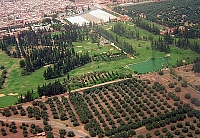 |
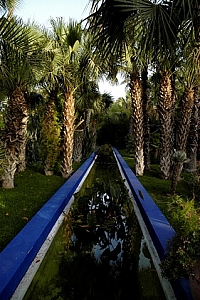 |
|

